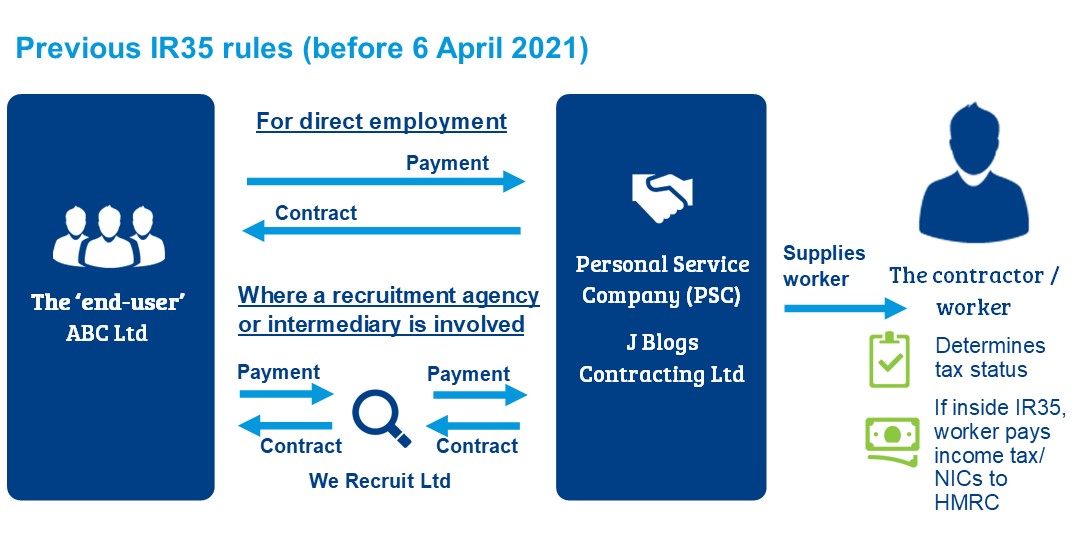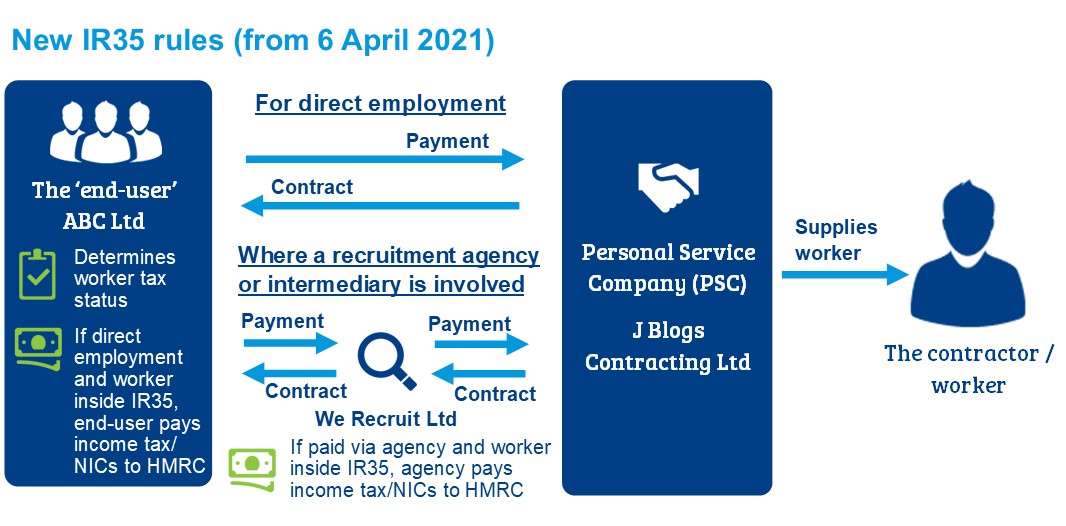The old and new rules
Out with the old – What were the previous rules?
IR35 is a set of tax rules which HMRC uses to combat tax avoidance. It uses this to determine whether workers should be classed (and then taxed) as employees rather than contractors/3rd parties when employed via an intermediary
Currently, if a Personal Service Company (PSC) (such as a contractor or freelancer operating via a limited company), is caught by the IR35 rules (known as inside IR35), it is the PSC themselves who are liable to account for and pay income tax and NICs due.
They are also liable for interest and penalties if HMRC determines an incorrect decision has been made on their employment status.

In with the new – What changed from April?
From 6 April 2021, the reformed IR35 rules shift the responsibility for determining the tax status of a contractor from the worker themselves to the ‘end-user’ (i.e the organisation who is ultimately receiving the individuals service).
If the ‘end-user’ determines that IR35 applies, the responsibility for operating the PAYE/NICs and paying the employer NICs and, where applicable the apprenticeship levy, now move from the PSC/contractor to the ‘fee payer’ (the organisation paying the PSC, such as the end-use or a recruitment agency/intermediary). They are also be liable for interest and penalties if HMRC determines an incorrect decision was made and that the worker should be classed (and taxed) as an ‘employee’ rather than a contractor. The new rules apply to any payments made on or after 6 April 2021, unless all the contractor’s labour was provided before that date.

Before you shake things up, there is an exemption for some
The small business exemption means that if the end-user engaging the worker is a ‘small businesses’ as defined by the Companies Act 2006 i.e. they meet two or more of the following criteria:
- Annual turnover is no more than £10.2m;
- Balance sheet total is no more than £5.1m;
- No more than 50 employees.
The responsibility for determining the IR35 status of a contract will remain with the personal service company and the new IR35 rules will not apply.
We say…
“The small business exemption throws up all kinds of questions marks for recruitment agencies and those hiring contractors. If the end-user is deemed a ‘small business’, might the agency or recruiter add to the job advert that this is the case? Given the public sector is said to receive 5 applications (for outside IR35 jobs) for every one (inside IR35 jobs) it might be worth including this in job listings. But it will mean keeping a check that the end-user is indeed small and not expanding past the exemption limits”.
How can you prepare?
- Review: Carry out a full review of all staff and contractors currently working within a business to try and identify which are bound by the new rules.
- Plan: Put new processes in place for how you will determine current and new staff/contractors employment status and who will carry this out? Decide where you will store the information and reason for your IR35 decision if future reference is needed or investigated by HMRC. Also establish procedures for dispute resolution where an assessment on employment is challenged by the contractor.
- Cost it: Work out the costs, in particular the additional NICs liability, to understand the additional costs. Are there other options, such as employing a worker through a accredited and tax-compliant umbrella company, where there is no PSC in the chain?
- Look ahead: Consider whether you need new recruitment procedures. Adverts should make clear whether the role is for a contracted period of work by a self-employed individual or intended as a more permanent consultant or contactor role.
IR35 FAQ
We hire contractors directly, what is now required?
There will be a number of steps to take when hiring contractors and to assess current contracts:
- Where you are an end-user, you are required to make an IR35 status decision.
- You must take ‘reasonable care’ in making that assessment and confirm your assessment together with reasons in a Status Determination Statement (SDS). See section below for further details on reasonable care.
- As the end-user you must provide the SDS to the contractor before making the first payment to them. The end-user is required to have a dispute resolution procedure to enable the contractor to challenge the assessment.
- If the assessment concludes that the contractor is out of scope of IR35, the PSC can continue to be paid gross. However, if the contractor is assessed as within IR35, the fee payer is responsible for operating PAYE and deducting employee NICs on the fees it pays to the PSC (excluding VAT). The fee payer must also pay employer NICs and, where applicable, the apprenticeship levy.
- Deduct National Insurance and Income Tax at source from pay.
- Charge the client an equivalent sum if Employer NI is due.
- Pay the contractor their net pay (as opposed to gross invoice value).
- Pay and report on the taxes deducted to HMRC.
We use a recruitment agency, what is now required?
If there is a recruitment agency supplying the contractor via a PSC, the end-user/hiring firm must also provide the Status Determination Statement (SDS) to the agency. It must also provide a dispute resolution procedure to the agency which it must also provide to the contractor, who are both able to appeal against the assessment. If the agency is the fee-payer, the agency will need to operate the PAYE/NICs and pay the employer NICs and, where applicable the apprenticeship levy.
What is considered ‘reasonable care’?
HMRC has published examples of behaviours that would indicate ‘reasonable care’ has been taken, which include:
- Accurately applying and keeping a record of the employment status principles set out in HMRC guidance – ESM0500.
- Accurately completing HMRC’s Check Employment Status for Tax (CEST) tool. This is an online tool to determine employment status, however it is not mandatory and the taxman reserves the right to challenge the tool’s judgement. The tool was updated in November 2019 following criticism, but it still has flaws such as it fails to consider mutuality of obligation (MOO), one of the key tests of employment.
- Seeking the advice of a qualified, professional advisor if the business lacks an understanding of IR35 legislation to make a decision with ‘reasonable care’.
- Having someone with a good understanding of the work to be undertaken involved in the determination process.
- Checking existing individual determinations to ensure they remain valid/accurate.
- Reviewing the processes being applied and amending for future determinations where necessary.
- If there are any material changes to a worker’s terms and conditions, or working practices, making a new status determination.
- Ensuring the checking and reviewing of processes of other parties where the determination process is subcontracted to another party. The client remains responsible for the accuracy of the SDS even if it subcontracts that responsibility to another party.
What are the key factors which determine if a worker is inside or outside IR35?
HMRC’s Check Employment Status for Tax (CEST) tool is influenced by the nature of the working relationship and here are some of the key determining factors:
- Is the worker under your direct control? The truly self-employed have more influence over how they complete their work. So the contract and working practices must show that the client has no influence over how the contractor performs their services. A contract indicating that a contractor will be supervised by a line manager or company employee, or which includes work start, break and end times could point towards an employment scenario.
- Will the worker be using their own equipment and machinery, or using the company’s? The later could point towards an employment scenario.
- Does the worker provide services to others? The self-employed would generally work for a number of clients at once. If you have workers who solely use your firm for work this could raise the prospect of an employment status.
- Does the contractor expect work on a regular basis? Problems may arise if, for example, an end client cannot terminate a contract for services immediately, but instead has to provide notice, or if there is a ‘rolling’ contract rather than a fixed-length contract. These points could indicate that a mutuality of obligation is still in place at the end of the initial contract period.
- How do you pay your contractors? The regularity of payments can have some influence on an IR35 decision, especially if paid a fixed, hourly or day rate, instead of paid by the job.
- Does your contractor act like a legitimate business? For example, having a website and email address, company stationery, logo, VAT registration, insurance, own its equipment or carrying out any marketing or advertising.
We are a recruitment agency, what does this mean for us?
We act for a number of recruitment agencies who will be impacted by these changes. The legislation puts a burden of responsibility on the fee payer of the contractor, and very often this will be a recruitment agency.
Where the end-user determines that the contractor is within IR35, if an agency or third party is involved in paying the worker, they will need to deduct income tax and employee National Insurance (NI) and pay employer NI.
I am a contractor, working via a PSC, what does this mean for me?
For genuine contractors, freelancers, interim workers or consultants, this should mean no change to how you are taxed and it takes the onus away from you in determining your IR35 status.
For those who are captured by the IR35 rules, the financial impact of IR35 may be significant. It could reduce a worker’s net income by up to 25%, costing the typical limited company contractor thousands of pounds in additional income tax and NICs. Furthermore, end users/clients may be hesitant to employ contractors within IR35 in order to avoid additional costs.
Therefore, you may choose to review and change how you work, to ensure that you are operating outside of IR35. Understanding the considerations that determine employment status will help you and you can find details of this in the full HMRC guidance here – ESM0500.
Also, if you disagree with the decision made by the end-user/client, there should be a dispute resolution process in place for you to challenge this.
Contact us
Please contact us if you have specific queries and we can look into your IR35 concerns, or introduce dedicated IR35 specialists if required.

Award-winning chartered accountants offering tax, audit and advisory services.


